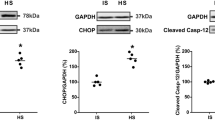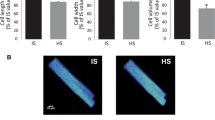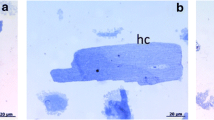Abstract
Hyperosmotic stress promotes rapid and pronounced apoptosis in cultured cardiomyocytes. Here, we investigated if Ca2+ signals contribute to this response. Exposure of cardiomyocytes to sorbitol [600 mosmol (kg water)−1] elicited large and oscillatory intracellular Ca2+ concentration increases. These Ca2+ signals were inhibited by nifedipine, Cd2+, U73122, xestospongin C and ryanodine, suggesting contributions from both Ca2+ influx through voltage dependent L-type Ca2+ channels plus Ca2+ release from intracellular stores mediated by IP3 receptors and ryanodine receptors. Hyperosmotic stress also increased mitochondrial Ca2+ levels, promoted mitochondrial depolarization, reduced intracellular ATP content, and activated the transcriptional factor cyclic AMP responsive element binding protein (CREB), determined by increased CREB phosphorylation and electrophoretic mobility shift assays. Incubation with 1 mM EGTA to decrease extracellular [Ca2+] prevented cardiomyocyte apoptosis induced by hyperosmotic stress, while overexpression of an adenoviral dominant negative form of CREB abolished the cardioprotection provided by 1 mM EGTA. These results suggest that hyperosmotic stress induced by sorbitol, by increasing Ca2+ influx and raising intracellular Ca2+ concentration, activates Ca2+ release from stores and causes cell death through mitochondrial function collapse. In addition, the present results suggest that the Ca2+ increase induced by hyperosmotic stress promotes cell survival by recruiting CREB-mediated signaling. Thus, the fate of cardiomyocytes under hyperosmotic stress will depend on the balance between Ca2+-induced survival and death pathways.









Similar content being viewed by others
Abbreviations
- AdLacZ:
-
Adenovirus β-galactosidase
- Ad dnCREB:
-
Adenovirus dominant negative CREB
- AIF:
-
Apoptosis inducing factor
- [Ca2+]i:
-
Intracellular calcium concentration
- CICR:
-
Ca2+-induced Ca2+ release
- CaMK:
-
Calmodulin kinase
- CREB:
-
Cyclic AMP responsive element binding protein
- CsA:
-
Cyclosporin A
- ERK:
-
Extracellular signal-regulated kinase
- fluo3-AM:
-
Fluo3 acetoximethylester
- IP3:
-
Inositol-1,4,5-trisphosphate
- IP3R:
-
IP3 receptor
- LY:
-
LY294002
- MAPK:
-
Mitogen activated protein kinase
- MOI:
-
Multiplicity of infection
- p38:
-
p38-Mitogen activated protein kinase
- PD:
-
PD98059
- PLC:
-
Phospholipase C
- RuRed:
-
Ruthenium red
- SB:
-
SB203580
- SERCA:
-
Sarco/endoplasmic reticulum Ca2+-ATPase
- TMRM:
-
Tetramethylrhodamine methyl ester
References
Davies MJ (2000) The cardiomyopathies: an overview. Heart 83:469–474
Bing OH (1994) Hypothesis: apoptosis may be a mechanism for the transition to heart failure with chronic pressure overload. J Mol Cell Cardiol 26:943–948
Olivetti G, Abbi R, Quaini F, Kajstura J, Cheng W, Nitahara JA, Quaini E, Di Loreto C, Beltrami CA, Krajewski S, Reed JC, Anversa P (1997) Apoptosis in the failing human heart. N Engl J Med 336:1131–1141
Galvez A, Morales MP, Eltit JM, Ocaranza P, Carrasco L, Campos X, Sapag-Hagar M, Diaz-Araya G, Lavandero S (2001) A rapid and strong apoptotic process is triggered by hyperosmotic stress in cultured rat cardiac myocytes. Cell Tissue Res 304:279–285
Wright AR, Rees SA (1998) Cardiac cell volume: crystal clear or murky waters? A comparison with other cell types. Pharmacol Ther 80:89–121
Hoover HE, Thuerauf DJ, Martindale JJ, Glembotski CC (2000) Alpha B-crystallin gene induction and phosphorylation by MKK6-activated p38. A potential role for alpha B-crystallin as a target of the p38 branch of the cardiac stress response. J Biol Chem 275:23825–23833
Takatani T, Takahashi K, Uozumi Y, Shikata E, Yamamoto Y, Ito T, Matsuda T, Schaffer SW, Fujio Y, Azuma J (2004) Taurine inhibits apoptosis by preventing formation of the Apaf-1/caspase-9 apoptosome. Am J Physiol 287:C949–C953
Takatani T, Takahashi K, Uozumi Y, Matsuda T, Ito T, Schaffer SW, Fujio Y, Azuma J (2004) Taurine prevents the ischemia-induced apoptosis in cultured neonatal rat cardiomyocytes through Akt/caspase-9 pathway. Biochem Biophys Res Commun 316:484–489
Burg MB, Kwon ED, Kultz D (1997) Regulation of gene expression by hypertonicity. Annu Rev Physiol 59:437–455
Galvez AS, Ulloa JA, Chiong M, Criollo A, Eisner V, Barros LF, Lavandero S (2003) Aldose reductase induced by hyperosmotic stress mediates cardiomyocyte apoptosis—differential effects of sorbitol and mannitol. J Biol Chem 278:38484–38494
Distelhorst CW, Shore GC (2004) Bcl-2 and calcium: controversy beneath the surface. Oncogene 23:2875–2880
Hanson CJ, Bootman MD, Roderick HL (2004) Cell signalling: IP3 receptors channel calcium into cell death. Curr Biol 14:R933–R935
Kruman I, Guo Q, Mattson MP (1998) Calcium and reactive oxygen species mediate staurosporine-induced mitochondrial dysfunction and apoptosis in PC12 cells. J Neurosci Res 51:293–308
Lynch K, Fernandez G, Pappalardo A, Peluso JJ (2000) Basic fibroblast growth factor inhibits apoptosis of spontaneously immortalized granulosa cells by regulating intracellular free calcium levels through a protein kinase Cdelta-dependent pathway. Endocrinology 141:4209–4217
Martikainen P, Kyprianou N, Tucker RW, Isaacs JT (1991) Programmed death of nonproliferating androgen-independent prostatic cancer cells. Cancer Res 51:4693–4700
Tombal B, Denmeade SR, Isaacs JT (1999) Assessment and validation of a microinjection method for kinetic analysis of [Ca2+]i in individual cells undergoing apoptosis. Cell Calcium 25:19–28
Zirpel L, Lippe WR, Rubel EW (1998) Activity-dependent regulation of [Ca2+]i in avian cochlear nucleus neurons: roles of protein kinases A and C and relation to cell death. J Neurophysiol 79:2288–2302
Jiang S, Chow SC, Nicotera P, Orrenius S (1994) Intracellular Ca2+ signals activate apoptosis in thymocytes: studies using the Ca2+-ATPase inhibitor thapsigargin. Exp Cell Res 212:84–92
Pinton P, Ferrari D, Magalhaes P, Schulze-Osthoff K, Di Virgilio F, Pozzan T, Rizzuto R (2000) Reduced loading of intracellular Ca2+ stores and downregulation of capacitative Ca2+ influx in Bcl-2-overexpressing cells. J Cell Biol 148:857–862
Wertz IE, Dixit VM (2000) Characterization of calcium release-activated apoptosis of LNCaP prostate cancer cells. J Biol Chem 275:11470–11477
Bito H, Takemoto-Kimura S (2003) Ca(2+)/CREB/CBP-dependent gene regulation: a shared mechanism critical in long-term synaptic plasticity and neuronal survival. Cell Calcium 34:425–430
Persengiev SP, Green MR (2003) The role of ATF/CREB family members in cell growth, survival and apoptosis. Apoptosis 8:225–228
Brindle PK, Montminy MR (1992) The CREB family of transcription activators. Curr Opin Genet Dev 2:199–204
Deisseroth K, Mermelstein PG, Xia H, Tsien RW (2003) Signaling from synapse to nucleus: the logic behind the mechanisms. Curr Opin Neurobiol 13:354–365
Foncea R, Andersson M, Ketterman A, Blakesley V, Sapag-Hagar M, Sugden PH, LeRoith D, Lavandero S (1997) Insulin-like growth factor-I rapidly activates multiple signal transduction pathways in cultured rat cardiac myocytes. J Biol Chem 272:19115–19124
Ibarra C, Estrada M, Carrasco L, Chiong M, Liberona JL, Cardenas C, Diaz-Araya G, Jaimovich E, Lavandero S (2004) Insulin-like growth factor-1 induces an inositol 1,4,5-trisphosphate-dependent increase in nuclear and cytosolic calcium in cultured rat cardiac myocytes. J Biol Chem 279:7554–7565
Morales MP, Galvez A, Eltit JM, Ocaranza P, Diaz-Araya G, Lavandero S (2000) IGF-1 regulates apoptosis of cardiac myocyte induced by osmotic-stress. Biochem Biophys Res Commun 270:1029–1035
Hetz C, Bono MR, Barros LF, Lagos R (2002) Microcin E492, a channel-forming bacteriocin from Klebsiella pneumoniae, induces apoptosis in some human cell lines. Proc Natl Acad Sci USA 99:2696–2701
Villena J, Henriquez M, Torres V, Moraga F, Diaz-Elizondo J, Arredondo C, Chiong M, Olea-Azar C, Stutzin A, Lavandero S, Quest AF (2008) Ceramide-induced formation of ROS and ATP depletion trigger necrosis in lymphoid cells. Free Radic Biol Med 44:1146–1160
Klemm DJ, Watson PA, Frid MG, Dempsey EC, Schaack J, Colton LA, Nesterova A, Stenmark KR, Reusch JE (2001) cAMP response element-binding protein content is a molecular determinant of smooth muscle cell proliferation and migration. J Biol Chem 276:46132–46141
Duchen MR (1999) Contributions of mitochondria to animal physiology: from homeostatic sensor to calcium signalling and cell death. J Physiol 516:1–17
Benard G, Bellance N, James D, Parrone P, Fernandez H, Letellier T, Rossignol R (2007) Mitochondrial bioenergetics and structural network organization. J Cell Sci 120:838–848
Gunter TE, Buntinas L, Sparagna G, Eliseev R, Gunter K (2000) Mitochondrial calcium transport: mechanisms and functions. Cell Calcium 28:285–296
Juretic N, Urzua U, Munroe DJ, Jaimovich E, Riveros N (2007) Differential gene expression in skeletal muscle cells after membrane depolarization. J Cell Physiol 210:819–830
Beekman RE, van Hardeveld C, Simonides WS (1988) Effect of thyroid state on cytosolic free calcium in resting and electrically stimulated cardiac myocytes. Biochim Biophys Acta 969:18–27
Hallaq H, Hasin Y, Fixler R, Eilam Y (1989) Effect of ouabain on the concentration of free cytosolic Ca2+ and on contractility in cultured rat cardiac myocytes. J Pharmacol Exp Ther 248:716–721
Erickson GR, Alexopoulos LG, Guilak F (2001) Hyper-osmotic stress induces volume change and calcium transients in chondrocytes by transmembrane, phospholipid, and G-protein pathways. J Biomech 34:1527–1535
Fernandes J, Lorenzo IM, Andrade YN, Garcia-Elias A, Serra SA, Fernandez-Fernandez JM, Valverde MA (2008) IP3 sensitizes TRPV4 channel to the mechano- and osmotransducing messenger 5′-6′-epoxyeicosatrienoic acid. J Cell Biol 181:143–155
Berridge MJ, Lipp P, Bootman MD (2000) The versatility and universality of calcium signalling. Nat Rev Mol Cell Biol 1:11–21
Berridge MJ, Bootman MD, Roderick HL (2003) Calcium signalling: dynamics, homeostasis and remodelling. Nat Rev Mol Cell Biol 4:517–529
Wang SQ, Song LS, Lakatta EG, Cheng H (2001) Ca2+ signalling between single L-type Ca2+ channels and ryanodine receptors in heart cells. Nature 410:592–596
Boitano S, Dirksen ER, Sanderson MJ (1992) Intercellular propagation of calcium waves mediated by inositol trisphosphate. Science 258:292–295
Rizzuto R, Pozzan T (2006) Microdomains of intracellular Ca2+: molecular determinants and functional consequences. Physiol Rev 86:369–408
Carafoli E (2002) Calcium signaling: a tale for all seasons. Proc Natl Acad Sci USA 99:1115–1122
Rizzuto R, Brini M, Murgia M, Pozzan T (1993) Microdomains with high Ca2+ close to IP3-sensitive channels that are sensed by neighboring mitochondria. Science 262:744–747
Orrenius S, Zhivotovsky B, Nicotera P (2003) Regulation of cell death: the calcium-apoptosis link. Nat Rev Mol Cell Biol 4:552–565
Gustafsson AB, Gottlieb RA (2008) Heart mitochondria: gates of life and death. Cardiovasc Res 77:334–343
Javadov S, Karmazyn M (2007) Mitochondrial permeability transition pore opening as an endpoint to initiate cell death and as a putative target for cardioprotection. Cell Physiol Biochem 20:1–22
Criollo A, Galluzzi L, Chiara MM, Tasdemir E, Lavandero S, Kroemer G (2007) Mitochondrial control of cell death induced by hyperosmotic stress. Apoptosis 12:3–18
Colell A, Ricci JE, Tait S, Milasta S, Maurer U, Bouchier-Hayes L, Fitzgerald P, Guio-Carrion A, Waterhouse NJ, Li CW, Mari B, Barbry P, Newmeyer DD, Beere HM, Green DR (2007) GAPDH and autophagy preserve survival after apoptotic cytochrome c release in the absence of caspase activation. Cell 129:983–997
Holler N, Zaru R, Micheau O, Thome M, Attinger A, Valitutti S, Bodmer JL, Schneider P, Seed B, Tschopp J (2000) Fas triggers an alternative, caspase-8-independent cell death pathway using the kinase RIP as effector molecule. Nat Immunol 1:489–495
Scheller C, Knoferle J, Ullrich A, Prottengeier J, Racek T, Sopper S, Jassoy C, Rethwilm A, Koutsilieri E (2006) Caspase inhibition in apoptotic T cells triggers necrotic cell death depending on the cell type and the proapoptotic stimulus. J Cell Biochem 97:1350–1361
Chen TY, Chi KH, Wang JS, Chien CL, Lin WW (2009) Reactive oxygen species are involved in FasL-induced caspase-independent cell death and inflammatory responses. Free Radic Biol Med 46:643–655
Green DR, Kroemer G (2004) The pathophysiology of mitochondrial cell death. Science 305:626–629
Christensen MLM, Braunstein TH, Treiman M (2008) Fluorescence assay for mitochondrial permeability transition in cardiomyocytes cultured in a microtiter plate. Anal Biochem 378:25–31
Hwang YC, Kaneko M, Bakr S, Liao H, Lu Y, Lewis ER, Yan S, Ii S, Itakura M, Rui L, Skopicki H, Homma S, Schmidt AM, Oates PJ, Szabolcs M, Ramasamy R (2004) Central role for aldose reductase pathway in myocardial ischemic injury. FASEB J 18:1192–1199
Srivastava SK, Ramana KV, Bhatnagar A (2005) Role of aldose reductase and oxidative damage in diabetes and the consequent potential for therapeutic options. Endocr Rev 26:380–392
Dragunow M (2004) CREB and neurodegeneration. Front Biosci 9:100–103
Shankar DB, Cheng JC, Sakamoto KM (2005) Role of cyclic AMP response element binding protein in human leukemias. Cancer 104:1819–1824
Walton M, Woodgate AM, Muravlev A, Xu R, During MJ, Dragunow M (1999) CREB phosphorylation promotes nerve cell survival. J Neurochem 73:1836–1842
Pugazhenthi S, Nesterova A, Sable C, Heidenreich KA, Boxer LM, Heasley LE, Reusch JE (2000) Akt/protein kinase B up-regulates Bcl-2 expression through cAMP-response element-binding protein. J Biol Chem 275:10761–10766
Wang JM, Chao JR, Chen W, Kuo ML, Yen JJ, Yang-Yen HF (1999) The antiapoptotic gene mcl-1 is up-regulated by the phosphatidylinositol 3-kinase/Akt signaling pathway through a transcription factor complex containing CREB. Mol Cell Biol 19:6195–6206
Maldonado C, Cea P, Adasme T, Collao A, Diaz-Araya G, Chiong M, Lavandero S (2005) IGF-1 protects cardiac myocytes from hyperosmotic stress-induced apoptosis via CREB. Biochem Biophys Res Commun 336:1112–1118
Kornhauser JM, Cowan CW, Shaywitz AJ, Dolmetsch RE, Griffith EC, Hu LS, Haddad C, Xia Z, Greenberg ME (2002) CREB transcriptional activity in neurons is regulated by multiple, calcium-specific phosphorylation events. Neuron 34:221–233
Mayr B, Montminy M (2001) Transcriptional regulation by the phosphorylation-dependent factor CREB. Nat Rev Mol Cell Biol 2:599–609
Acknowledgments
We thank Fidel Albornoz and Ruth Marquez for their technical assistance and Drs Paola Llanos and David Mears (Faculty of Medicine, Universidad de of Chile, Santiago, Chile) for their help with fura2-AM experiments. This work was supported by FONDAP (Fondo de Areas Prioritarias, Fondo Nacional de Desarrollo Cientifico y Tecnologico, CONICYT, Chile) grant 15010006 (to S. L., C. H., E. J.). We also thank the International Collaboration Program ECOS-CONICTY grants C04B03 and C08S01 (to G. K. and S. L.) and FONDECYT Postdoctoral Grant 3070043 (to V. E.). C. M., C. I., V. P., R. B., C. Q., A. C. and J. M. V. are recipients of Ph. D. fellowships from CONICYT, Chile. S. L. is in a sabbatical leave at The University of Texas Southwestern Medical Center, Dallas.
Conflicts of interest statement
The authors declare that they have no conflict of interest.
Author information
Authors and Affiliations
Corresponding author
Additional information
M. Chiong, V. Parra and V. Eisner contributed equally to this work.
Electronic supplementary material
Below is the link to the electronic supplementary material.
Supplementary Fig. 1
Hyperosmotic stress increases intracellular Ca2+ concentration in cultured cardiomyocytes. Cells preloaded with or fura2-AM were perfused with Ca2+-containing (black circles) or Ca2+-free (white circles) Krebs buffer and at the time indicated with an arrow cells were supplemented with sorbitol (Sor) (600 mosmol (kg water)−1). Using an inverted microscope equipped with a Xenon lamp, fura2-AM preloaded cells were excited at 340 nm and 380 nm, and monitored at 510 nm. The corresponding 340/380 fluorescence ratios were calculated. In the inset a more detailed fura2 340/380 fluorescence ratio in the first 75 s is depicted (TIFF 555 kb)
Supplementary Fig. 2
Hyperosmotic stress induces strong depolarization of cultured cardiomyocytes. The effect of hyperosmotic solutions on the membrane potential of cardiomyocytes was evaluated with the voltage-sensitive dye bis-(1,3-dibutylbarbituric acid)pentamethine oxonol (DiBAC4(3)) (Molecular Probes), an anionic dye that enters depolarized cells and exhibits enhanced fluorescence and green spectral shifts, so that increased fluorescence reflects increased membrane depolarization. Cardiac myocytes were incubated in Krebs buffer (145 mM NaCl, 5 mM KCl, 1 mM MgCl2, 2.6 mM CaCl2, 5.6 mM glucose, 10 mM HEPES, pH 7.4) for 10 min at 37°C; DiBAC4(3) dissolved in 0.2% DMSO was added to a final concentration of 300 nM and cells were further incubated for 10 min at 37°C. Cells preloaded with DiBAC4(3) were excited at 488 nm and monitored at 510 nm; fluorescence images were collected every 5 s in a confocal laser scanning inverted microscope (Zeiss LSM510). At the time indicated with an arrow, cells were perfused with Ca2+-containing Krebs buffer supplemented with sorbitol (Sor, 600 mosmol (kg water)−1). As control, DiBAC4(3) preloaded cardiomyocytes were depolarized by perfusion with Krebs buffer containing 20 mM, 50 mM or 80 mM KCl. Images were analyzed with ImageJ software and relative fluorescence (ΔF/Fo) values were determined. Values are the average ± S. E. M. of 4 independent experiments (TIFF 492 kb)
Supplementary Fig. 3
Effect of the pan caspase inhibitor Z-VAD-fmk on caspase 3 induction triggered by hyperosmotic stress. Cultured cardiomyocytes were exposed to sorbitol (600 mosmol (kg water)−1) or sorbitol supplemented with the pan-caspase inhibitor Z-VAD-fmk (10 μM). At different times, total protein extracts were prepared. Pro-caspase and caspase 3 were detected by Western blot analysis. Gels are representative of 3 different experiments. Results are given as mean ± SEM for 3 independent experiments. * P < 0.05 vs respective control 0 h, # P <0.05 vs 2 h sorbitol (TIFF 871 kb)
Supplementary Fig. 4
Cyclosporin A does not protect cardiomyocytes from cell death induced by hyperosmotic stress. Cardiomyocytes were preincubated 30 min with 0.5 μM cyclosporin A (CsA) and were then stimulated with culture media supplemented with sorbitol (600 mosmol (kg water)−1) for 24 h. Panel A. Cell viability was determined by the trypan blue exclusion method. Results are given as mean ± S. E. M. of 6 independent experiments. * P <0.05 vs control. Panel B. DNA laddering analysis was performed in DNA extracted using the chloroform:phenol method, fractionated by electrophoresis in 2% agarose gels and visualized by ethidium bromide/UV. The standard corresponds to 100 bp DNA ladder. Results are given as mean ± S. E. M. of 3 independent experiments. * P < 0.05 vs control (TIFF 1163 kb)
Supplementary Fig. 5
Effect of the expression of a dominant negative CREB on cardiac myocyte viability. Panel A: Cultured cardiomyocytes were transduced with an adenovirus overexpressing dominant negative CREB (Ad dnCREB) at a different multiplicity of infection (MOI). A LacZ adenovirus (Ad LacZ) was used as control. Cells were transduced for 48 h in DME:199 (4:1) and cell viability was determined as indicated in Materials and methods. Panel B: Cultured cardiomyocytes were transduced for 48 h with Ad dnCREB or Ad LacZ at MOI = 300. Total protein extracts were obtained and CREB and β-actin protein levels were determined by Western blot analysis using anti CREB or anti β-actin polyclonal antibody, respectively. CREB/β-actin levels were 2.0 ± 0.3 and 1.0 ± 0.2 in cardiomyocytes transduced with Ad dnCREB or Ad LacZ, respectively (TIFF 1806 kb)
Rights and permissions
About this article
Cite this article
Chiong, M., Parra, V., Eisner, V. et al. Parallel activation of Ca2+-induced survival and death pathways in cardiomyocytes by sorbitol-induced hyperosmotic stress. Apoptosis 15, 887–903 (2010). https://doi.org/10.1007/s10495-010-0505-9
Published:
Issue Date:
DOI: https://doi.org/10.1007/s10495-010-0505-9




